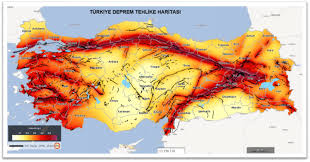
Ground Effect in Kahramanmaraş Earthquakes
The article titled "Non-linear site response and liquefaction analysis of soil site in Kahramanmaras during the Mw 7.7 and Mw 7.6 Turkey earthquakes", written by Dr. Ersin Güler, a lecturer in the Department of Construction of our University Sivrihisar Vocational School, Engineering Science and Technology, an International Journal It was published in the magazine.
In Turkey, one of the most important earthquake regions in Europe, two major earthquakes (Mw: 7.7 and 7.6) occurred in Kahramanmaraş province on February 6, 2023, approximately 8 hours apart. Approximately 50 thousand people died and approximately 250 thousand injured people were treated in the earthquake that affected Kahramanmaraş province and 10 surrounding provinces, located on the South Anatolian Fault Line. It has been observed that these large earthquakes occurring repeatedly have a devastating effect on the structures both in the epicenter and in the surrounding provinces. When the reason for this effect was examined, it was determined that the building stock of the region was old, as well as the peak ground acceleration (PGA) values formed on the surface and to which the buildings were exposed. For this reason, in building designs, it is necessary to determine the risks that the buildings will be exposed to from the ground and to define the ground profile and take the necessary precautions.
Our University Sivrihisar Vocational School Construction Department Lecturer. Ersin Güler's article titled "Non-linear site response and liquefaction analysis of soil site in Kahramanmaras during the Mw 7.7 and Mw 7.6 Turkey earthquakes" published in Engineering Science and Technology, an International Journal states that the problems of ground amplification and soil liquefaction due to earthquakes should be examined. and stated that it is important to make these analyzes site-specific in building designs. In this context, a total of 6 drilling points in Kahramanmaraş province were examined. Ground expansion and liquefaction potential were determined in the risk analyzes performed at the determined points. Analyzes were carried out with these drilling data obtained from the earthquake region. In the analysis, 33 earthquake acceleration records were used, including 11 acceleration records from the nearest stations of the Pazarcık earthquake, 11 acceleration records from the nearest stations of the Elbistan earthquake, and 11 selected earthquake acceleration records reflecting the seismic characteristics of the region. As a result of the analysis and comparison of the results with the Turkish Building Earthquake Regulation, it was concluded that "Due to the ground structure, more damages occurred in the buildings than expected and this study will help us develop the necessary measures to reduce them." The statement is included. In the study, site-specific analyzes were made and both ground amplification and liquefaction potential risk analyzes were performed. In addition, comparisons were made with the spectral acceleration values recommended by TBDY 2018 for the region and suggestions were presented.
In the research, it was determined that the ground structure should be examined specifically for the site and spot measures should be taken on ground amplification and ground liquefaction. As stated in the article, the ground structure greatly affects the earthquake acceleration values and there can be great differences in the acceleration values reaching the surface from the bedrock even between close places.
Access to article: https://doi.org/10.1016/j.jestch.2024.101751





